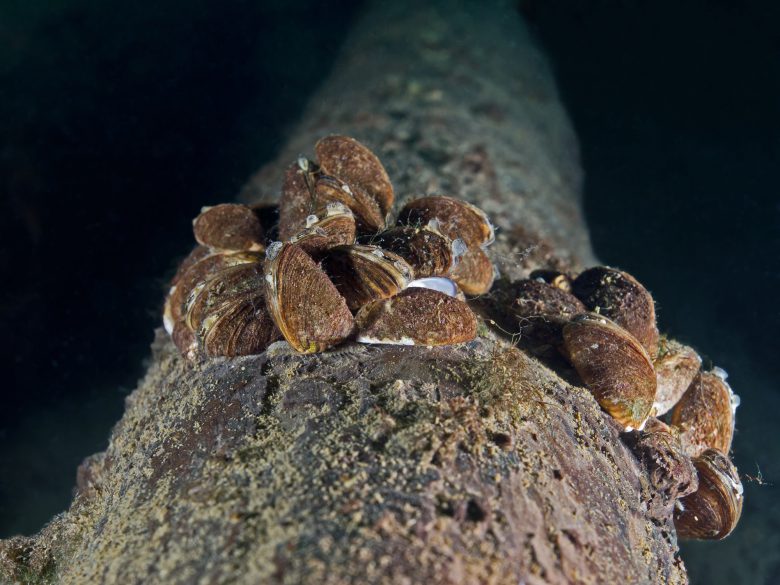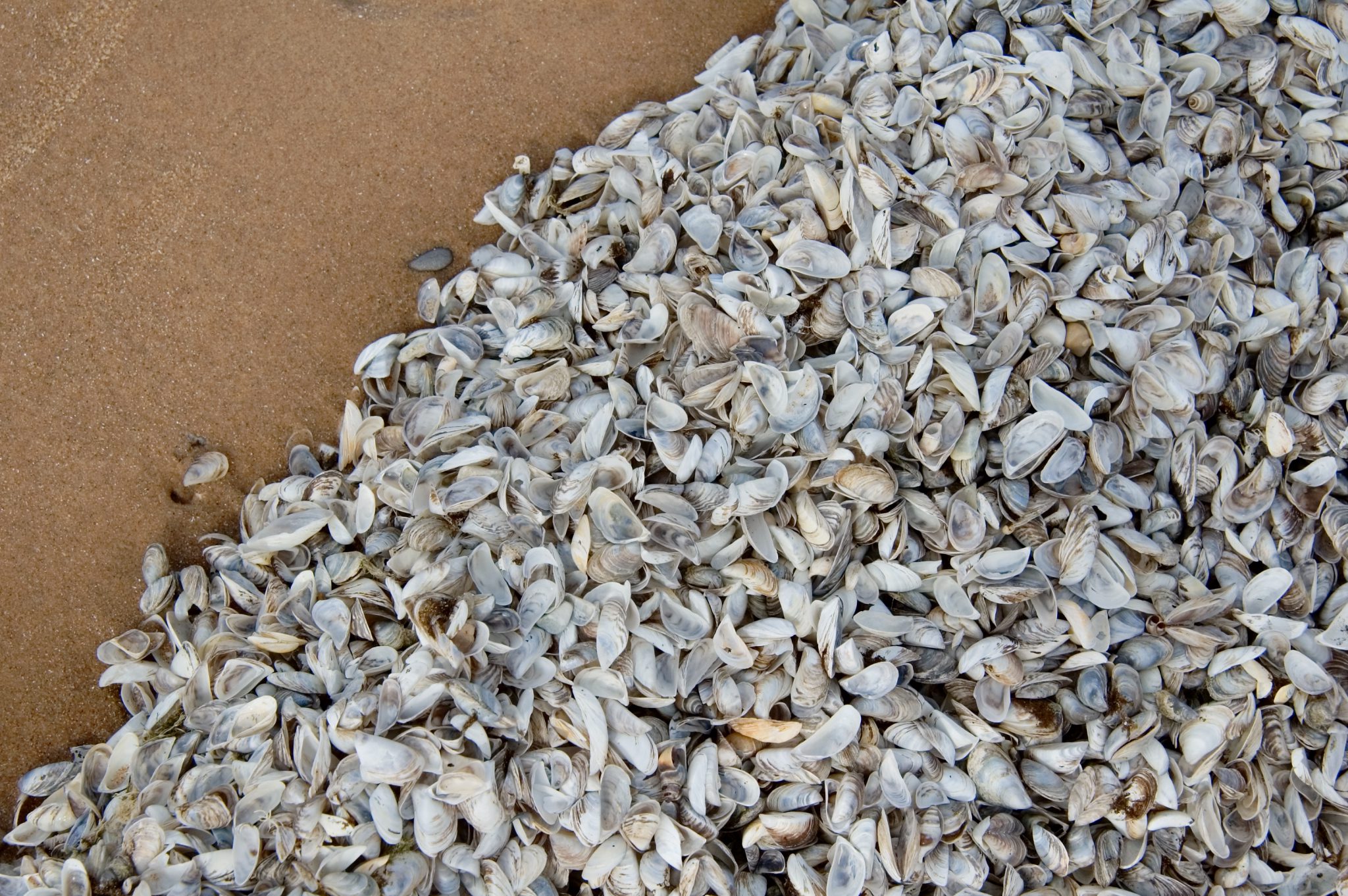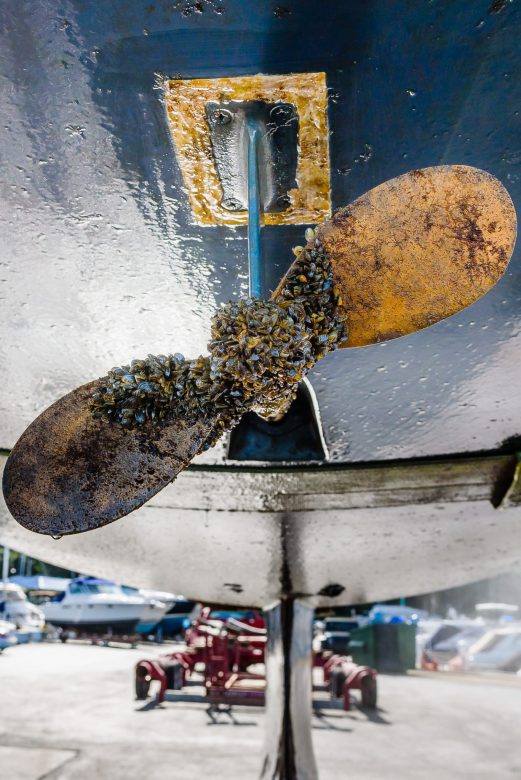Research May 27, 2024
Zebra Mussels in Manitoba: Here are the facts
By Scott Higgins, Research Scientist
If you live in Manitoba, you are likely familiar with the annual advisories encouraging lake users to protect our bodies of water from invasive species, such as zebra mussels.
But do you really understand why zebra mussels are dangerous to our water? Moreover, what can you do about them?
Our research scientist Scott Higgins breaks it down for you…
First up, what are zebra mussels?
Zebra mussels are small (typically smaller than 2 cm) freshwater molluscs originating from the Black Sea region of Eastern Europe. Zebra mussels are filter feeders. This means that they filter and eat algae and other particles from the water.
Unlike nearly all other freshwater molluscs (such as clams and snails), zebra mussels grow while attached to hard surfaces such as rocks and plants and, unfortunately, boats, motors, and water intakes. One of their other unique qualities is the density in which they congregate. For example, it is common to find more than 10,000 individual mussels per square metre on hard surfaces.

When did zebra mussels arrive in Canada?
Zebra mussels were first detected in Lake Erie in 1986. Within a few years, they had spread all around Lake Erie and into the rest of the Great Lakes. Within 10 years, zebra mussels had travelled from the Great Lakes to smaller inland lakes, through the Mississippi drainage to the Gulf of Mexico. They now occupy over 800 lakes, mostly in eastern North America.
Do we know how zebra mussels first arrived in Manitoba?
We will likely never know for sure.
The current weight of evidence, however, suggests that they came in via the Red River, either in the form of a veliger (microscopic early life stage), or as adults floating down the river, attached to debris or plant material. It is also possible that they arrived overland attached to a boat or other equipment being transported from an invaded habitat. The closest invaded habitats were in North Dakota and Minnesota.

How widely have zebra mussels invaded freshwater bodies in Manitoba?
Zebra mussels have been found in the Red River in several locations, throughout the north and south basins of Lake Winnipeg and throughout the Nelson River, which drains Lake Winnipeg into Hudson’s Bay, and Lake Manitoba.
A veliger was detected in Cedar Lake, immediately west of Lake Winnipeg’s north basin. More recently, in the fall of 2023, several adult zebra mussels were found in Clear Lake (Riding Mountain National Park).
What effects will zebra mussels have on aquatic ecosystems in Manitoba?
In general, rivers and smaller lakes tend to be affected the most, followed by the areas closest to the shore (“nearshore”) within larger lakes. However, as we have learned from the Laurentian Great Lakes, even very large lakes like Lake Winnipeg are not immune.
In terms of their effects on the food web, zebra mussels filter out phytoplankton, which are algae at the base of freshwater food webs. When zebra mussel populations become large, they can outcompete native species for phytoplankton, leading to declines in small invertebrates and the fish that rely on them for food.
In nearshore areas of lakes, zebra mussels improve water clarity and fertilize the lake bottom with their waste products. In some lakes, increased light and increased nutrients have led to large increases in aquatic plants and filamentous benthic algae (algae that grow in long stringy filaments on the lake bottom). In lakes Erie, Michigan, Ontario and portions of Lake Huron, these nearshore algal blooms are so severe that they have clogged industrial water intakes and led to beach closures.
Because zebra mussels grow on hard surfaces and in very high densities, they colonize most hard surfaces in the lakes they invade, including rocky areas, hard sediments, and any infrastructure like docks, buoys, boats and other watercraft, and water intakes that require frequent decontamination. Beachgoers should consider wearing appropriate footwear (e.g., water shoes) before entering the water as the mussel shells are sharp and can easily cut through the skin.
What will we likely see in Clear Lake specifically?
It is not a certainty that zebra mussels will establish themselves in Clear Lake; given that they were detected early, eradication remains possible.
However, if zebra mussels are not eradicated, they will quickly spread around the lake over the next few years. Lake users will find that rocky surfaces and hard infrastructure like docks and boats that are left in the water will become heavily colonized with zebra mussels and will need to be routinely cleaned.
As the zebra mussel population increase in size, the effects on the food web will increase and would, most likely, include significant declines or complete loss of native mussels, and reductions in phytoplankton, insects, and many fish species. In nearshore areas, increased growth of submerged plants or attached algae may occur.
If zebra mussels are able to establish in Clear Lake, it would represent the most western location where they are found in Canada and increase the risk of further spread throughout Manitoba and other western provinces. The lake would be a potential source of zebra mussels into other nearby waterbodies, such as the Little Saskatchewan River, the Assiniboine River and other nearby lakes and rivers.
As the number of lakes and rivers that are colonized increases, so does the damage to ecosystems and the economic costs. For example, the government of British Columbia has estimated that if zebra mussels were to become widely colonized there, the costs could exceed 100 million dollars annually.

In the meantime, what can the public and other lake users do?
All lakes in proximity to the Clear Lake watershed are now at risk of being invaded, so the most important action that individuals can take is to ensure that they thoroughly clean items (boats, boat trailers, buoys, etc.) removed from Clear Lake before placing them into another waterbody.
Second, boat hulls, motors, water intakes, and other “in-lake” infrastructure will likely require increased maintenance.
Third, if you live or access areas of the lake where adult zebra mussels are found, you should be cautious and wear correct footwear in the water. The shells of the mussels can be quite sharp when stepped on and can easily cut exposed skin.
The government of Manitoba has updated information on how to identify zebra mussels, how to report sightings, and how to decontaminate watercraft.